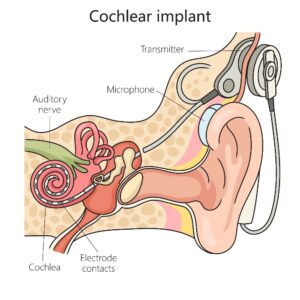Imagine a world of muffled voices and missed laughter suddenly coming alive. Cochlear implants make this possible, giving people with severe hearing loss a chance to reconnect with sound. In this article, a consultant ENT surgeon explains how these devices work, their transformative benefits, and the practical realities patients should know before taking the leap.
WORDS LIM TECK CHOON
 FEATURED EXPERT FEATURED EXPERTDR SHAILENDRA SIVALINGAM Consultant Ear, Nose and Throat Surgeon Sunway Medical Centre |
Inside the ear is a snail-like structure called the cochlea. When we talk about listening with our ear, the cochlea is the structure that allows us to hear in the first place.
Hearing loss can occur when the cochlea is unable to properly function. This is where cochlear implants can be useful to improve the affected person’s ability to still ‘hear’.
| We use ‘hear’ because the person wearing a cochlear implant doesn’t detect and process sounds like someone with a normal-functioning cochlea will. |
HOW A COCHLEAR IMPLANT WORKS
Now, there are 2 parts of a cochlear implant.

External Part
- The external part is placed behind the ear.
- This part comes with a microphone that will pick up sounds.
- This part will process the sound and transmit relevant information to the internal part of the implant.
Internal Part
- The internal part is placed under the skin, behind the ear, via simple outpatient surgery.
- It comes with a thin wire and small electrodes that connect to the cochlea.
- When this part receives information from the external part, it transmits the information to the nerve of the cochlea.
- The cochlear nerve then sends the sound information to the brain, thus letting the person become aware of the sound picked up by the implant.
This process is not completely the same as normal hearing, but given time and practice, the person wearing the implant will become more alert to the sounds around them.
ROBOT-ASSISTED TECHNOLOGY TO IMPROVE THE COCHLEAR IMPLANT SURGERY
Dr Shailendra Sivalingam shares with us that cochlear implant surgery is now made easier and more efficient with the use of 3-dimensional (3D for short) exoscope.
- A 3D exoscope is a high-definition digital imaging system.
- It allows the surgeon to have a magnified 3D image of the area being operated on.
- With a clear view of the operated area, the surgeon can perform the surgery more precisely.
This can come with some benefits to the patient, such as:
- Smaller surgical incisions
- Smaller risk of bleeding
- Faster recovery
“With the exoscope, precise and complicated surgical maneuvers were performed flawlessly,” says Dr Shailendra.
WHAT HAPPENS AFTER THE SURGERY?
Activation
- The cochlear implant will be activated 2 weeks after the surgery.
- During this period, the patient’s family and friends can attempt communication using text to reassure the patient and make the patient feel more at ease.
Adjustment
Initially, the wearer of the implant may need some time to adjust to the use of the implant, as hearing through the implant is not like normal hearing.
Implant Mapping
- The implant will also need to be tuned and adjusted, and this process is called implant mapping.
- This process can take up to 6 months after surgery, although the exact duration can be shorter or longer depending on how the wearer responds to the implant.
| This article is part of our series on health issues related to the ear, nose, and throat. |








